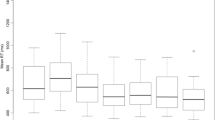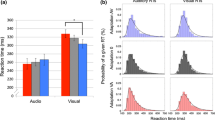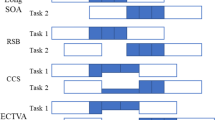Abstract
To increase the efficiency of multimodal user interfaces, one has to design them according to how multimodal features appear in the real world. Although spatial coincidence and matching intensity levels are important for perception, these factors received little attention in human–computer interaction studies. In our present study we aimed to map how spatial coincidence and different intensity levels influence response times. Sixteen participants performed a simple auditory localization task, where sounds were presented either alone or together with visual non-targets. We found that medium intensity visual stimuli facilitated responses to low intensity sounds. Analyses of response time distributions showed that intensity of target and non-target stimuli affected different parameters of the ex-Gaussian distribution. Our results suggest that multisensory integration and response facilitation may occur even if the non-target has low predictive power to the location of the target. Furthermore, we show that the parameters of the ex-Gaussian distribution can be related to distinct cognitive processes. The current results are potentially applicable in the design of an intelligent warning system that employs the user’s reaction time to adapt the warning signal for optimal results.



Similar content being viewed by others
References
Barany P, Csapo A (2012) Definition and synergies of cognitive infocommunications. Acta Polytech Hung 9(1):67–83
Ho C, Reed N, Spence C (2007) Multisensory in-car warning signals for collision avoidance. Human Factors 49(6):1107–1114
Ho C, Santangelo V, Spence C (2009) Multisensory warning signals: when spatial correspondence matters. Expl Brain Res 195(2):261–272
Meredith MA, Stein BE (1986) Visual, auditory, and somatosensory convergence on cells in superior colliculus results in multisensory integration. J Neurophysiol 56(3):640–662
Meredith MA, Stein BE (1983) Interactions among converging sensory inputs in the superior colliculus. Science (New York, N.Y.) 221(4608):389–391
Stein BE, Meredith MA (1993) The merging of the senses. MIT Press, p 224
Ohshiro T, Angelaki DE, DeAngelis GC (2011) A normalization model of multisensory integration. Nat Neurosci 14(6):775–782
Ghazanfar AA, Schroeder CE (2006) Is neocortex essentially multisensory? Trends Cognit Sci 10(6):278–285
McGurk H, MacDonald J (1976) Hearing lips and seeing voices. Nature 264(5588):746–748
Senkowski D, Saint-Amour D, Höfle M, Foxe JJ (2011) Multisensory interactions in early evoked brain activity follow the principle of inverse effectiveness. NeuroImage 56(4):2200–2208
Bolognini N, Leo F, Passamonti C, Stein BE, Làdavas E (2007) Multisensory-mediated auditory localization. Perception 36(10):1477–1485
Leo F, Bolognini N, Passamonti C, Stein BE, Làdavas E (2008) Cross-modal localization in hemianopia: new insights on multisensory integration. Brain 131(Pt 3):855–865
Colonius H, Diederich A (2012) Focused attention vs. crossmodal signals paradigm: deriving predictions from the time-window-of-integration model. Front Integr Neurosci 6:62
Morgan ML, Deangelis GC, Angelaki DE (2008) Multisensory integration in macaque visual cortex depends on cue reliability. Neuron 59(4):662–673
Fetsch CR, Pouget A, DeAngelis GC, Angelaki DE (2012) Neural correlates of reliability-based cue weighting during multisensory integration. Nat Neurosci 15(1):146–154
Lacouture Y, Cousineau D (2008) How to use MATLAB to fit the ex-Gaussian and other probability functions to a distribution of response times. Tutor Quant Methods Psychol 4(1):35–45
Whelan R (2008) Effective analysis of reaction time data. Psychol Record 58(3):475–482
Török Á, Asbóth KK, Honbolygó F, Csépe V (2012) Intensity dependent interaction in audiovisual integration. In: Proceedings of the 3rd IEEE conference on cognitive infocommunications, pp 469–473
Boersma P (2001) Praat, a system for doing phonetics by computer. Glot Int 5(9–10):341–345
Miller J (1988) A warning about median reaction time. J Exp Psychol 14(3):539–543
Diederich A, Colonius H (2004) Bimodal and trimodal multisensory enhancement: effects of stimulus onset and intensity on reaction time. Percept Psychophys 66(8):1388–1404
Di Russo F, Martínez A, Sereno MI, Pitzalis S, Hillyard SA (2002) Cortical sources of the early components of the visual evoked potential. Hum Brain Mapp 15(2):95–111
Kuriki S, Nogai T, Hirata Y (1995) Cortical sources of middle latency responses of auditory evoked magnetic field. Hear Res 92(1–2):47–51
Fort A, Delpuech C, Pernier J, Giard M-H (2002) Dynamics of cortico-subcortical cross-modal operations involved in audio-visual object detection in humans. Cerebral Cortex (New York, N.Y.: 1991) 12(10):1031–1039
Giard MH, Peronnet F (1999) Auditory-visual integration during multimodal object recognition in humans: a behavioral and electrophysiological study. J Cognit Neurosci 11(5):473–490
Perrault TJ, Vaughan JW, Stein BE, Wallace MT (2005) Superior colliculus neurons use distinct operational modes in the integration of multisensory stimuli. J Neurophysiol 93(5):2575–2586
Alais D, Burr D (2004) The ventriloquist effect results from near-optimal bimodal integration. Curr Biol 14(3):257–262
Wozny DR, Shams L (2011) Recalibration of auditory space following milliseconds of cross-modal discrepancy. J Neurosci 31(12):4607–4612
Fujisaki W, Shimojo S, Kashino M, Nishida S (2004) Recalibration of audiovisual simultaneity. Nat Neurosci 7(7):773–778
Bertelson P, Aschersleben G (1998) Automatic visual bias of perceived auditory location. Psychon Bull Rev 5(3):482–489
Vroomen J, De Gelder B (2004) Perceptual effects of cross-modal stimulation: ventriloquism and the freezing phenomenon. Handb Multisens Process 3(1):1–23
Diederich A, Schomburg A, Colonius H (2012) Saccadic reaction times to audiovisual stimuli show effects of oscillatory phase reset. PLoS ONE 7(10):e44910
Ghirardelli TG, Scharine AA (2009) Auditory-visual interactions. In: Letowski, Russo MB, Tomasz R (eds) Helmet-mounted displays: sensation, perception, and cognition issues. U.S. Army Aeromedical Research, pp 599–618
Acknowledgments
The publication was supported by the KTIA_AIK_12-1-2013-0037 project. The project is supported by Hungarian Government, managed by the National Development Agency, and financed by the Research and Technology Innovation Fund.
Author information
Authors and Affiliations
Corresponding author
Electronic supplementary material
Below is the link to the electronic supplementary material.
Rights and permissions
About this article
Cite this article
Török, Á., Kolozsvári, O., Virágh, T. et al. Effect of stimulus intensity on response time distribution in multisensory integration. J Multimodal User Interfaces 8, 209–216 (2014). https://doi.org/10.1007/s12193-013-0135-y
Received:
Accepted:
Published:
Issue Date:
DOI: https://doi.org/10.1007/s12193-013-0135-y




